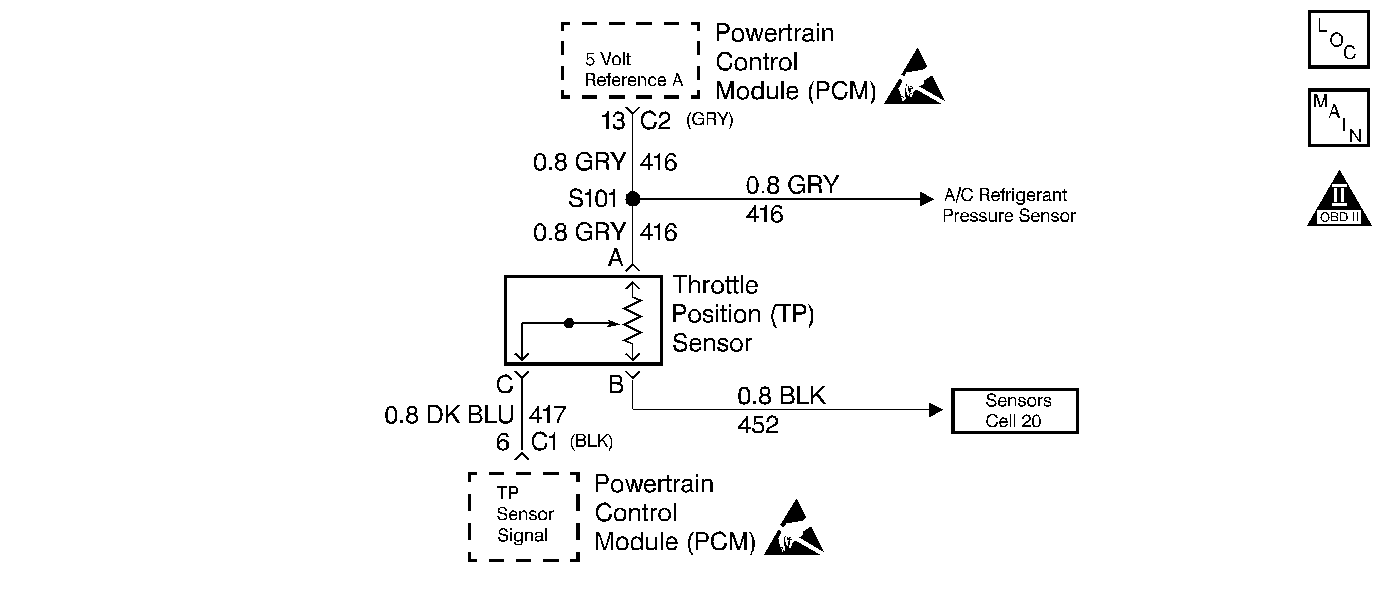
Circuit Description
The PCM supplies a 5V reference signal and a ground to the TP sensor. The TP sensor sends a voltage signal back to the PCM relative to throttle blade opening. Voltage will vary from 0.20 V at closed throttle to over 4.5 V at wide open throttle.
Conditions For Setting The DTC
| • | The MAP sensor reads less than 37 kPa. |
| • | The TP sensor is stable ± 2 %. |
| • | One or more of the following DTCs are not set P0107, P0108. |
| • | Whenever the TP angle is greater than one of the following specified percentage at the given RPM. |
| - | The TP angle is greater than 52 % at 1600 RPM. |
| - | The TP angle is greater than 73 % at 2400 RPM. |
| - | The TP angle is greater than 99 % at 3200 RPM. |
| - | The TP angle is greater than 100 % at 4000 RPM. |
Action Taken When the DTC Sets
| • | The Malfunction Indicator Lamp (MIL) illuminates after 2 consecutive ignition cycles in which the diagnostic runs with the fault active. |
| • | The PCM records the operating conditions at the time the diagnostic fails. The Freeze Frame and Failure Records buffers stores this information. |
| • | A history DTC is stored. |
Conditions for Clearing the MIL/DTC
| • | The malfunction indicator lamp (MIL) will turn OFF after 3 consecutive ignition cycles in which the diagnostic runs without a fault. |
| • | A history DTC will clear after 40 consecutive warm up cycles without a fault. |
| • | Use a scan tool to clear the DTCs. |
Diagnostic Aids
Whenever this DTC cannot be duplicated, use the information included in the Freeze Frame. Use the Data in order to determine the conditions when the DTC sets.
Test Description
The numbers below refer to the step numbers on the diagnostic table.
-
The Powertrain OBD System Check prompts the technician to complete some basic checks and store the Freeze Frame Data and the Failure records on the scan tool if applicable. This creates an electronic copy of the data taken when the fault occurred. This information on the scan tool can be referred to later.
-
The TP sensor has an auto zeroing feature. Whenever the voltage reading is between 0.2 to 0.9 volts, the PCM will assume that the TP sensor is at a closed throttle position. Whenever the reading is out of the auto zeroing range at closed throttle look for a binding or damaged linkage.
-
Before replacing the PCM, check terminals for improper mating, broken locks, or physical damage to the wiring harness. Reprogram the replacement PCMs. Refer to the latest Techline information for programming procedures.
Step | Action | Value(s) | Yes | No |
|---|---|---|---|---|
Was the Powertrain On-Board Diagnostic (OBD) System Check performed? | -- | |||
Does the TP angle value increase steadily to the specified value when the accelerator pedal is depressed? Does the TP angle value decrease steadily to the specified value when the pedal is released? | 95 % 2 % | |||
3 |
Is the TP angle vs RPM value greater than the specified value in the conditions for setting this DTC? | -- | ||
4 | Disconnect the TP sensor electrical connector. Is the TP sensor voltage less than the specified value? | 0.5 V | ||
5 | Connect a test lamp between the 5 volt reference circuit and the TP sensor signal circuit at the TP sensor electrical connector. Is the TP sensor greater than the specified value? | 4.5 V | ||
6 |
Was a repair made? | -- | ||
7 |
Was a repair made? | -- | ||
8 |
Was a repair made? | -- | ||
9 |
Is the action complete? | -- | ||
10 | Replace the TP sensor. Refer to Throttle Position Sensor Replacement . Is the action complete? | -- | -- | |
Replace the PCM. Refer to Powertrain Control Module Replacement/Programming . Is the action complete? | -- | -- | ||
12 |
Does the scan tool indicate that this diagnostic ran and passed? | 90°-95° C | ||
13 | Check if any additional DTCs are set. Are any DTCs displayed that have not been diagnosed? | -- | Go to the Applicable DTC Table | System OK |
